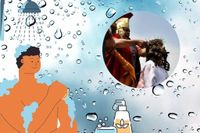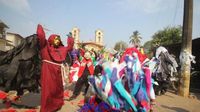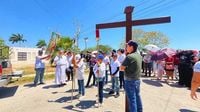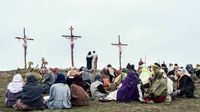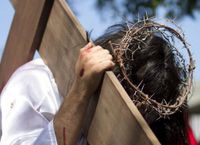In the small town of Coacotla, the vibrant celebrations of Semana Santa (Holy Week) are a time of unity and fervor, engaging nearly the entire community. This year, the festivities are particularly lively, with the most significant events taking place between Thursday, April 17, 2025, and Good Friday, April 18, 2025. The celebrations blend deep religious significance with a colorful display of tradition, drawing in participants of all ages.
As the second Friday of Lent approaches, the town prepares for an influx of activity. From Holy Thursday to Good Friday, young people don costumes ranging from animals to characters from popular culture, including tigers, coyotes, and even political figures. These participants, referred to as 'Jews' or 'Pilates', split into groups of deer and muleteers, engaging in playful yet intense mock battles under the watchful eyes of 'the watchmen', who carry staffs adorned with colorful ribbons.
At 4 p.m. on Good Friday, the climax of the festivities occurs as the Saint is taken from the burial place and placed in front of the church. The atmosphere thickens as the 'Jews' amplify their howls and screams, creating a chaotic scene that requires restraint to prevent them from rushing forward. The tension escalates when a centurion arrives on horseback, surrounded by 'the roosters'. Dismounting, he brandishes a machete to trace a cross in the ground, skillfully cutting a large flower without damaging the Saint in the coffin. This act symbolizes both reverence and the community's connection to their faith.
Following the Stations of the Cross, the images are set before the main altar, and the crowd begins to disperse, while the 'Jews' continue their tour of the town's neighborhoods, anticipating the opening of the 'glory' the next day. This tradition signifies the retreat of evil, culminating in a night procession that includes children dressed as 'angelitos' (little angels).
As the celebrations unfold, it’s essential to understand the broader significance of Holy Week for Christians worldwide. This period commemorates the passion, death, and resurrection of Jesus Christ, marking the end of Lent, a 40-day period of penance. It is considered the most pivotal time in the Christian calendar.
Palm Sunday, which falls on April 13, 2025, marks the beginning of Holy Week, remembering Jesus' triumphant entry into Jerusalem. Churches often hold processions where palm leaves are distributed, some of which are saved to be burned into ashes for the following Ash Wednesday. Holy Thursday, April 17, 2025, honors the Last Supper, while Good Friday, April 18, 2025, is a day of mourning and reflection, centering on the crucifixion of Jesus.
On Good Friday, many Christians observe fasting and abstain from meat as a form of penance. This day is marked by solemnity, and traditional rituals such as the Via Crucis, which retraces Jesus' path to crucifixion, are performed. This year, the most significant liturgical celebration is expected to take place between 3 and 5 p.m., as the faithful gather to reflect on the profound implications of Christ's sacrifice.
Interestingly, a popular belief persists among some Catholics that bathing on Good Friday is taboo. Many hold that water is impure on this day, as it cannot be blessed, leading to the superstition that those who do bathe may face negative consequences, such as turning into a fish. This belief has roots in medieval traditions, where it was thought that getting wet could be dangerous. However, the Catholic Church does not officially prohibit bathing, emphasizing instead the importance of living the day with respect and reflection.
As the festivities continue into Holy Saturday, April 19, 2025, the atmosphere shifts. This day is traditionally associated with purification, where the act of throwing water at one another symbolizes renewal and celebration of the resurrection. However, in many regions, this practice has been curtailed due to concerns about water waste and environmental impact.
The culmination of Holy Week arrives on Resurrection Sunday, April 20, 2025, when Christians celebrate the resurrection of Jesus. This day is often marked by joyous gatherings, festive meals, and the continuation of various traditions that have evolved over centuries.
In Yucatán, the significance of Holy Week is deeply felt in families like that of Lucía Canul, who shared her experiences of attending mass and participating in church events with her loved ones. She noted that these days serve as a reminder of the pivotal moments in Jesus' life, emphasizing the importance of family unity and shared faith during this sacred time.
Lucía remarked, "These days are very important for me and my family. It’s when we remember all that Jesus did for us, and it’s also a time to be more united." This sentiment resonates with many in the region, where the traditions of fasting and abstinence continue to be observed, particularly on Good Friday. Eduardo Cámara, another parishioner, affirmed that fasting is a significant part of their customs, with many opting for minimal sustenance during this reflective period.
Despite the challenges posed by modern distractions, such as technology and changing lifestyles, many hope to keep these traditions alive. Lucía expressed her confidence that families will reconnect with their roots, emphasizing the importance of passing down these practices to future generations.
As Holy Week unfolds across Coacotla and beyond, the blend of tradition, faith, and community spirit shines brightly, reminding everyone of the enduring significance of these sacred days.
